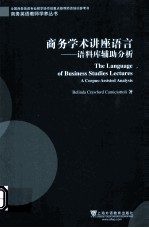

商务学术讲座语言 语料库辅助分析 英文版PDF电子书下载
- 电子书积分:10 积分如何计算积分?
- 作 者:卡密乔托里(BelindaCrawfordCamiciottoli)著
- 出 版 社:上海:上海外语教育出版社
- 出版年份:2014
- ISBN:9787544637633
- 页数:236 页
CHAPTER 1 Introduction 1
1.1 Rationale for the study 1
1.2 The university lecture:pros and cons 2
1.3 Aims of the study 4
1.4 Target readership 6
1.5 Overview of the book 6
CHAPTER 2 Background to the study:The merger of discourses 9
2.1 Introduction 9
2.2 Spoken discourse 9
2.2.1 The linguistic/discursive approach 10
2.2.2 The interactional approach 13
2.3 Academic discourse 15
2.4 Disciplinary discourse:the field of economics 21
2.5 Professional discourse:the world of business 25
2.6 A conceptual framework for analyzing business studies lectures 28
CHAPTER 3 The business studies lecture corpus:Design,collection and analysis 31
3.1 Introduction 31
3.2 Corpus design 31
3.3 Collecting the data 34
3.4 Transcribing the data 36
3.5 Methodology:an integrated approach 39
3.5.1 Quantitative and qualitative analysis 39
3.5.2 Comparative analysis 41
3.5.3 Behavioural observation 42
3.5.4 Participant feedback 43
CHAPTER 4 Speaking to the audience 45
4.1 Introduction 45
4.2 Speech rate 46
4.3 Lecture style 49
4.3.1 Discourse dysfluencies 52
4.3.2 Reduced forms 54
4.4 Lexical informality 57
4.4.1 Vagueness 58
4.4.2 Idioms 62
4.5 Syntactic informality 65
4.5.1 Ellipsis 66
4.5.2 Non-restrictive which-clauses 68
4.6 Lexical density 73
4.7 Summary of findings 76
CHAPTER 5 Interacting with the learners 79
5.1 Introduction 79
5.2 Discourse structuring 79
5.2.1 Lecture macrostructure 80
5.2.2 Macromarkers 84
5.2.3 Micromarkers 89
5.3 Evaluation 94
5.3.1 Relevance markers 96
5.3.2 Afiect markers 100
5.4 Lecturer-audience interaction 104
5.4.1 Questions 105
5.4.2 Comprehension checks 108
5.4.3 Dialogic episodes 109
5.5 Audience responsiveness and feedback 113
5.6 Summary of findings 115
CHAPTER 6 Teaching the discipline and the profession 119
6.1 Introduction 119
6.2 Disciplinary/professional orientations:a descriptive profile 120
6.3 Real vs.hypothetical worlds 122
6.4 Argumentation 125
6.5 Specialized lexis 127
6.5.1 Global analysis 128
6.5.2 Keyword analysis 131
6.5.3 Connections to Business English 135
6.5.4 Compounds and buzzwords 138
6.6 Metaphors 142
6.6.1 Global analysis 144
6.6.2 Comparative analysis 147
6.7 Summary of findings 148
CHAPTER 7 Beyond speaking:Multimodal aspects 151
7.1 Introduction 151
7.2 The visual mode 153
7.2.1 The analytical framework 154
7.2.2 The analysis 155
7.2.2.1 Visual typologies in the BSLC 158
7.2.2.2 Comparative analysis 163
7.3 The nonverbal mode 165
7.3.1 Methodology in nonverbal studies 168
7.3.2 The analysis 169
7.3.2.1 Interpersonal episodes 170
7.3.2.2 Nonverbal behaviours of the 1ecturers 171
7.3.2.3 A microanalysis of one lecturer's nonverbal behav-iours 177
7.4 Summary of findings 181
CHAPTER 8 Final remarks 183
8.1 Introduction 183
8.2 Aims,findings,pedagogical implications and research prospects 183
8.3 Methodological insights 188
8.4 Business studies lectures and interdiscursivity revisited 189
References 193
Appendix A-Transcript samples from the twelve lectures of the BSLC 213
Appendix B-Specialized lexis in the BSLC ranked according to frequency 227
Name index 231
Subject index 235
- 《卓有成效的管理者 中英文双语版》(美)彼得·德鲁克许是祥译;那国毅审校 2019
- 《复旦大学新闻学院教授学术丛书 新闻实务随想录》刘海贵 2019
- 《俞士镇学术文存 下》俞士镇著;俞元江,俞元淮整理 2019
- 《中国经典文化走向世界丛书 学术卷 2》龚海燕译 2019
- 《跟孩子一起看图学英文》张紫颖著 2019
- 《万里云天万里路 国医大师邓铁涛师承团队学术精华》邱仕君,刘小斌,邓中光 2018
- 《复分析 英文版》(中国)李娜,马立新 2019
- 《唐墓壁画国际学术研讨会论文集》陕西历史博物馆编 2006
- 《张世祥小提琴启蒙教程 中英文双语版》张世祥编著 2017
- 《如何指导博士生学术写作 给导师的教学法》(澳)芭芭拉·凯姆勒(Barbara Kamler),帕特·托马斯(Pat Thomson)著 2020
- 《重塑法国》(法)埃马纽埃尔·马克龙埃里克·福托里诺编钱培鑫译 2019
- 《狼的生活艺术》(法)莫纳托里著;周彦译 2013
- 《国际空间合作 欧洲空间局范例》(法)罗格·博奈,(意)维托里·曼诺著 2014
- 《骑行宝典 单车维修保养完全手册 彩印》(英)斯托里著;潘震译 2014
- 《哥谭女》(美)斯托里著;(美)格雷夫斯等绘;刘杰译 2005
- 《科学小侦探 墓地“幽灵”事件》(美)托里著;(美)纽曼绘;高楠译 2011
- 《聚焦》(美)海蒂·格兰特·霍尔沃森,(美)E.托里·希金斯著;张金凤译 2017
- 《骑行宝典 单车维修保养完全手册 第7版》(英)詹姆斯·威特,(英)马克·斯托里著;潘震译 2018
- 《绘声绘色 勇敢的救护车》(法)克莱尔·克莱蒙文;(日)玛里·托里戈图;刘文英译 2018
- 《商务学术讲座语言 语料库辅助分析 英文版》卡密乔托里(BelindaCrawfordCamiciottoli)著 2014
- 《培智学校义务教育实验教科书教师教学用书 生活适应 二年级 上》人民教育出版社,课程教材研究所,特殊教育课程教材研究中心编著 2019
- 《习近平总书记教育重要论述讲义》本书编写组 2020
- 《办好人民满意的教育 全国教育满意度调查报告》(中国)中国教育科学研究院 2019
- 《教育学考研应试宝典》徐影主编 2019
- 《语文教育教学实践探索》陈德收 2018
- 《家庭音乐素养教育》刘畅 2018
- 《学前教育学》王换成主编 2019
- 《近代体育游戏教育史料汇编 第1辑 1》王强主编 2016
- 《全国学前教育专业(新课程标准)“十三五”规划教材 简谱手风琴教程 第2版》(中国)杨克勤,王宝庆 2019
- 《现代教育技术》李志河主编 2019
